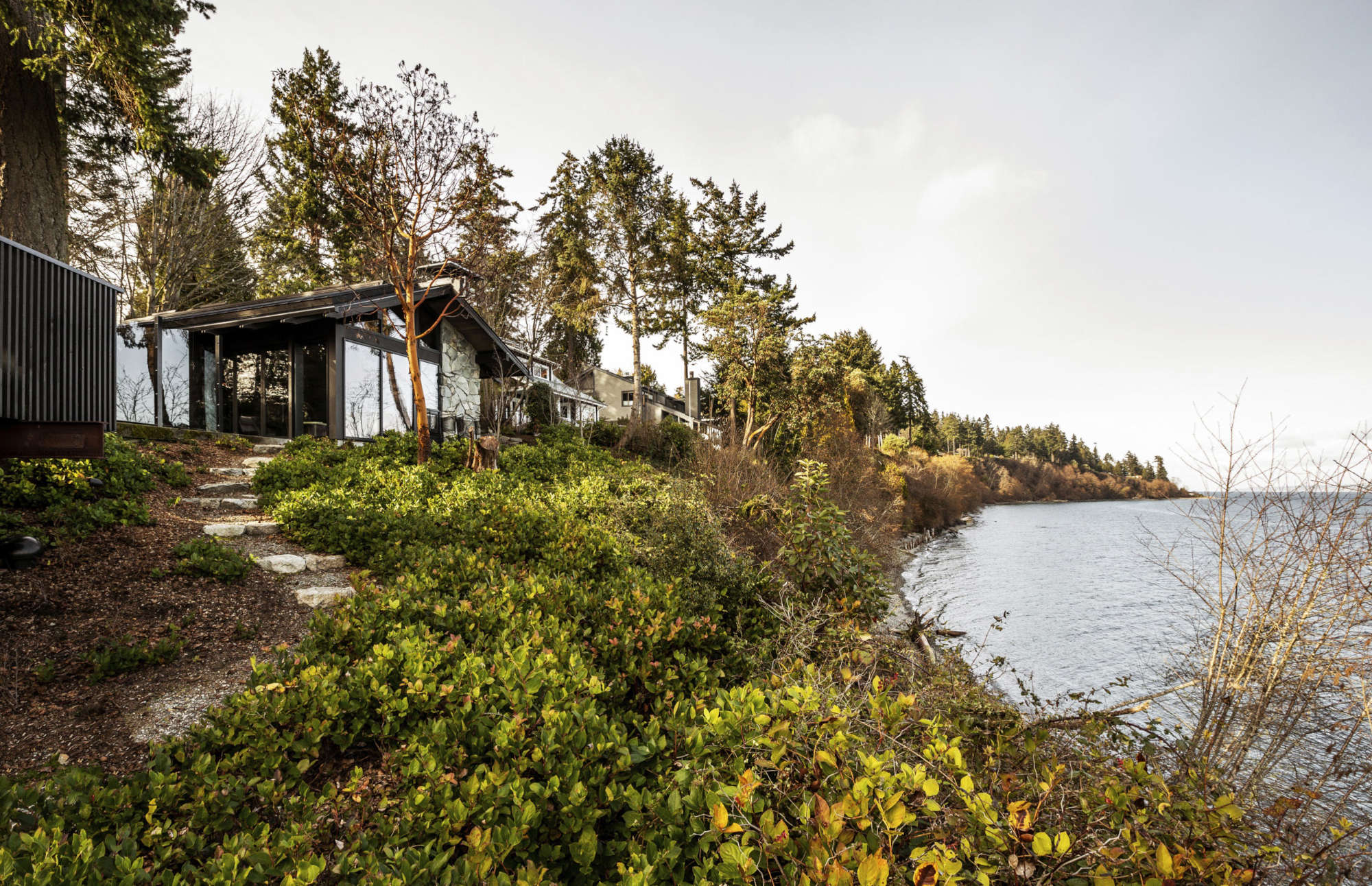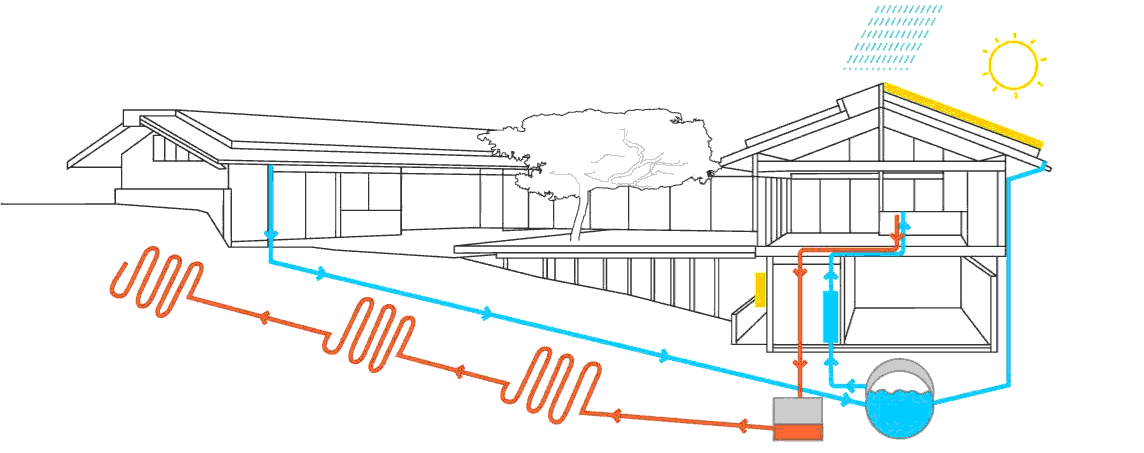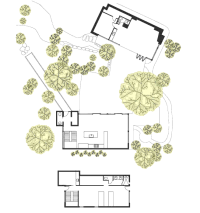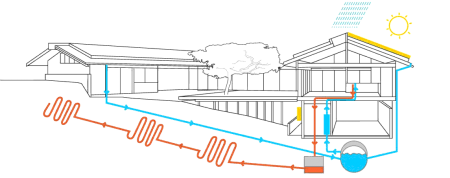Differenze tra le versioni di "Dwell - Ripple Effect"
GFA (Discussione | contributi) m |
GFA (Discussione | contributi) m |
||
| Riga 10: | Riga 10: | ||
|autori = Text by Melissa Dalton. Photography by Rafael Soldi - Dwell, May 2021 | |autori = Text by Melissa Dalton. Photography by Rafael Soldi - Dwell, May 2021 | ||
}} | }} | ||
| + | |||
| + | {{blockquote|[[File:Dwell_-_May_2021_-_Ripple_Effect_perma2.png|200px|left]] | ||
| + | [[File:Dwell_-_May_2021_-_Ripple_Effect_perma1.png|450px|right]] | ||
| + | |||
| + | The house meets LBC standards for net-positive water, on-site water treatment, and net-positive energy. To create a closed-loop system, potable water (blue) is collected via the rooftop and stored in an underground fiberglass cistern that holds 10,000 gallons. “In three weeks in January this year, we captured enough water for six months of use in the house,” says Todd. That rainwater is purified via a filtration system in the lower-level mechanical room before reaching faucets. A septic tank outfitted with a textile filter scrubs gray water and black-water (orange) for non-potable use, such as irrigation. An array of 42 solar panels supplies 105 percent of the property’s power needs (yellow), and two wall-mounted batteries store backup power.}} | ||
| + | |||
| + | |||
</div> | </div> | ||
<div class="bgno"> | <div class="bgno"> | ||
| Riga 18: | Riga 25: | ||
<blockquote>A home on Bainbridge Island may be the most ecologically ambitious residential renovation in the world.</blockquote> | <blockquote>A home on Bainbridge Island may be the most ecologically ambitious residential renovation in the world.</blockquote> | ||
| + | |||
| + | <div class="fullwidth"> | ||
| + | {{blockquote|[[File:Dwell_-_May_2021_-_Ripple_Effect_perma1.png]] | ||
| + | |||
| + | The house meets LBC standards for net-positive water, on-site water treatment, and net-positive energy. To create a closed-loop system, potable water (blue) is collected via the rooftop and stored in an underground fiberglass cistern that holds 10,000 gallons. “In three weeks in January this year, we captured enough water for six months of use in the house,” says Todd. That rainwater is purified via a filtration system in the lower-level mechanical room before reaching faucets. A septic tank outfitted with a textile filter scrubs gray water and black-water (orange) for non-potable use, such as irrigation. An array of 42 solar panels supplies 105 percent of the property’s power needs (yellow), and two wall-mounted batteries store backup power.}} | ||
| + | </div> | ||
</div> | </div> | ||
<pdf>File:Dwell - May 2021 - Ripple Effect.pdf</pdf> | <pdf>File:Dwell - May 2021 - Ripple Effect.pdf</pdf> | ||
Versione attuale delle 16:43, 19 lug 2021

Dwell
Ripple Effect
A home on Bainbridge Island may be the most ecologically ambitious residential renovation in the world.
Text by Melissa Dalton. Photography by Rafael Soldi - Dwell, May 2021
The house meets LBC standards for net-positive water, on-site water treatment, and net-positive energy. To create a closed-loop system, potable water (blue) is collected via the rooftop and stored in an underground fiberglass cistern that holds 10,000 gallons. “In three weeks in January this year, we captured enough water for six months of use in the house,” says Todd. That rainwater is purified via a filtration system in the lower-level mechanical room before reaching faucets. A septic tank outfitted with a textile filter scrubs gray water and black-water (orange) for non-potable use, such as irrigation. An array of 42 solar panels supplies 105 percent of the property’s power needs (yellow), and two wall-mounted batteries store backup power.
Melissa Dalton
Maggio 2021
A home on Bainbridge Island may be the most ecologically ambitious residential renovation in the world.
 The house meets LBC standards for net-positive water, on-site water treatment, and net-positive energy. To create a closed-loop system, potable water (blue) is collected via the rooftop and stored in an underground fiberglass cistern that holds 10,000 gallons. “In three weeks in January this year, we captured enough water for six months of use in the house,” says Todd. That rainwater is purified via a filtration system in the lower-level mechanical room before reaching faucets. A septic tank outfitted with a textile filter scrubs gray water and black-water (orange) for non-potable use, such as irrigation. An array of 42 solar panels supplies 105 percent of the property’s power needs (yellow), and two wall-mounted batteries store backup power.
The house meets LBC standards for net-positive water, on-site water treatment, and net-positive energy. To create a closed-loop system, potable water (blue) is collected via the rooftop and stored in an underground fiberglass cistern that holds 10,000 gallons. “In three weeks in January this year, we captured enough water for six months of use in the house,” says Todd. That rainwater is purified via a filtration system in the lower-level mechanical room before reaching faucets. A septic tank outfitted with a textile filter scrubs gray water and black-water (orange) for non-potable use, such as irrigation. An array of 42 solar panels supplies 105 percent of the property’s power needs (yellow), and two wall-mounted batteries store backup power.The URL or file path given does not exist.


